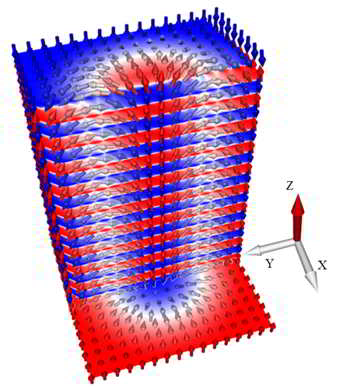From Johannes Gutenberg University Mainz: Third Dimension of Data Storage
Three-dimensional magnetic vortices in synthetic antiferromagnets move differently than magnetic vortices in two dimensions
This is a Press Release edited by StorageNewsletter.com on October 22, 2025 at 2:00 pmFrom Johannes Gutenberg University Mainz
Typically, the charge of electrons is used to store and process information in electronics based devices.
Three-dimensional magnetic skyrmion tube in a synthetic antiferromagnet
(illustration./©: Mona Bhukta)
In spintronics, the focus is instead on the magnetic moment or on magnetic vortices, so-called skyrmions – the goal is smaller, faster, and more sustainable computers. To further increase storage density, skyrmions will not only be two-dimensional in the future, but will also conquer the third dimension. Researchers from the Institute of Physics at Johannes Gutenberg University Mainz (JGU) have now succeeded in creating three-dimensional skyrmions, so-called hybrid skyrmion tubes, in synthetic antiferromagnets and have demonstrated for the 1st time that these skyrmion tubes move differently than two-dimensional skyrmions.
“Three-dimensional skyrmions are of interest for quantum computing and brain-inspired computing, among other things – here the higher storage density resulting from the third dimension is essential,” says Mona Bhukta, professor Mathias Kläui’s research group. The results were published on September 26 in the scientific journal Nature Communications.
The differences in the motion of skyrmions can be used to store information
Although skyrmions are magnetic vortices, they behave like particles. This means, among other things, that they can be moved by an electric current. Skyrmions are usually created in thin magnetic layers and thus in two dimensions; the first three-dimensional skyrmion tubes have already been detected. However, these 3D skyrmions were evenly twisted, which is referred to as homogeneous chirality. This means they move in the same way as skyrmions in two dimensions and offer no added value for data storage, as their information can be represented just as well on a single plane.
“We have now been able to create skyrmion tubes in synthetic antiferromagnets – that is, thinfilmusing standard deposition methods whose magnetization cancels outwards – and demonstrate for the first time that these skyrmion tubes move completely differently than skyrmions in two dimensions,” says Bhukta.
The reason for this lies in the structure of the new skyrmion tubes: Unlike previously created ones, they are not uniformly twisted, but unevenly. This leads to – to put it simply – they move differently than in 2D systems. These differences in movement can be used for information storage, thus opening up a third dimension for data storage.
The new skyrmion tubes were manufactured at JGU, and their three-dimensional structure was verified at the Jülich Research Center. Synchrotron sources at the BESSY II (Helmholtz Center Berlin for Materials and Energy) and at the Swiss Light Source of the Paul Scherrer Institute in Villigen, Switzerland, were used to study the movement of the skyrmion tubes.
The results are important, among other things, for so-called brain-inspired computing: data is to be processed not via digital electronics, but via neurons, i.e., nerve cells, and synapses – with the goal of creating more powerful, energy-efficient, and flexible systems for complex tasks.
“Three-dimensional skyrmions allow us to better mimic neurons,” says Bhukta. “The step into the third dimension is also essential in quantum computing.”
Article: Observation of a non-reciprocal skyrmion Hall effect of hybrid chiral skyrmion tubes in synthetic antiferromagnetic multilayers
Nature Communications has published an article written by Takaaki Dohi, Laboratory for Nanoelectronics and Spintronics, Research Institute of Electrical Communication, Tohoku University, Sendai, Japan, and Institut für Physik, Johannes Gutenberg-Universität Mainz, Mainz, Germany, Mona Bhukta, Fabian Kammerbauer, Venkata Krishna Bharadwaj, Ricardo Zarzuela, Institut für Physik, Johannes Gutenberg-Universität Mainz, Mainz, Germany, Aakanksha Sud, Laboratory for Nanoelectronics and Spintronics, Research Institute of Electrical Communication, Tohoku University, Sendai, Japan, and Frontier Research Institute for Interdisciplinary Sciences, Tohoku University, Sendai, Japan, Maria-Andromachi Syskaki, Institut für Physik, Johannes Gutenberg-Universität Mainz, Mainz, Germany, and Singulus Technologies AG, Kahl am Main, Germany, Duc Minh Tran, Institut für Physik, Johannes Gutenberg-Universität Mainz, Mainz, Germany, Thibaud Denneulin, Ernst Ruska-Centre for Microscopy and Spectroscopy with Electrons, Forschungszentrum Jülich, Jülich, Germany, Sebastian Wintz, Markus Weigand, Max Planck Institute for Intelligent Systems, Stuttgart, Germany, and Helmholtz-Zentrum Berlin für Materialien und Energie GmbH, Berlin, Germany, Simone Finizio, Jörg Raabe, Swiss Light Source, Paul Scherrer Institut, Villigen, PSI, Switzerland, Robert Frömter, Institut für Physik, Johannes Gutenberg-Universität Mainz, Mainz, Germany, Rafal E. Dunin-Borkowski, Ernst Ruska-Centre for Microscopy and Spectroscopy with Electrons, Forschungszentrum Jülich, Jülich, Germany, Jairo Sinova, Institut für Physik, Johannes Gutenberg-Universität Mainz, Mainz, Germany, and Mathias Kläui, Institut für Physik, Johannes Gutenberg-Universität Mainz, Mainz, Germany, and Center for Quantum Spintronics, Norwegian University of Science and Technology, Trondheim, Norway.
Abstract: “A hybrid chiral skyrmion tube is a well-known example of a 3D topological spin texture, exhibiting an intriguing chirality transition along the thickness direction. This transition progresses from left-handed to right-handed Néel-type chirality, passing through a Bloch-type intermediate state. Such an exotic spin configuration potentially exhibits distinctly different dynamics from that of the common skyrmion tube that exhibits a homogeneous chirality; yet these dynamics have not been ascertained so far. Here, we reveal the distinct features of current-induced dynamics that result from the hybrid chiral skyrmion tube structure in synthetic antiferromagnetic (SyAFM) multilayers. Strikingly, the SyAFM hybrid chiral skyrmion tubes exhibit a non-reciprocal skyrmion Hall effect in the flow regime. The non-reciprocity can even be tuned by the degree of magnetic compensation in the SyAFM systems. Our theoretical modeling qualitatively corroborates that the non-reciprocity stems from the dynamic oscillation of skyrmion helicity during its current-induced motion. The findings highlight the critical role of the internal degrees of freedom of these complex skyrmion tubes for their current-induced dynamics.“














 Subscribe to our free daily newsletter
Subscribe to our free daily newsletter

